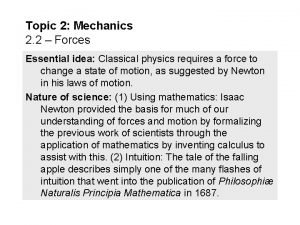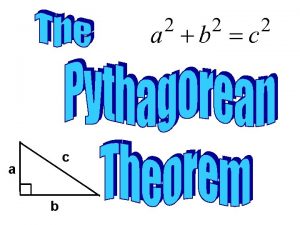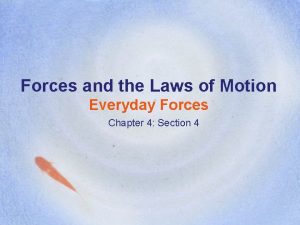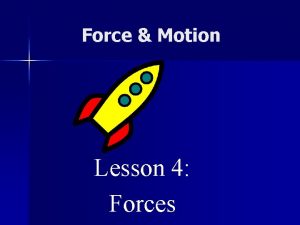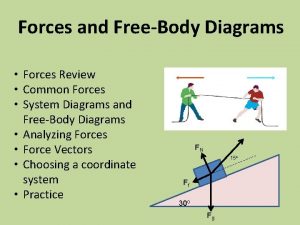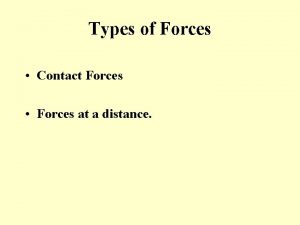Lesson 4 4 Everyday Forces Essential Question What


















































- Slides: 50

Lesson 4. 4 Everyday Forces Essential Question: What are some of the everyday forces?

• How do you know that a bowling ball weighs more than a tennis ball? Imagine holding one ball in each hand.

What is weight? • A measure of the gravitational force exerted on an object; its value can change with the location of the object in the universe.

• If an astronaut weighs 800 N (180 lb) on Earth, he would weigh only about 130 N (30 lb) on the moon. • Weight depends on location because it is equal to the magnitude of the force due to gravity.

• Imagine a television set at rest on a table. We know that the gravitational force is acting on the television. Why doesn’t the television continue to fall forward toward the center of the Earth?

What is the normal force? • A force that acts on a surface in a direction perpendicular to the surface.

• The normal force is always perpendicular to the contact surface but is not always opposite in direction to the force due to gravity. • In the absence of other forces, the normal force is equal and opposite to the component of the force of gravity that is perpendicular to the contact surface.


How do you calculate the magnitude of the normal force? • The angle is the angle between the normal force and a vertical line and is also the angle between the contact surface and a horizontal line.

What causes things to slide or to stick? • Friction causes our applied forces to work harder! • Friction opposes the applied force. • There is static friction and kinetic friction.

What is static friction? •

• The force of static friction is always equal to and opposite in direction to the component of the applied force that is parallel to the surface. • As the applied force increases, the force of static friction also increases.



What is kinetic friction? •

• Kinetic friction is always less than the maximum static friction.

• When two surfaces are stationary with respect to each other, the surfaces stick together somewhat at the contact points. • This adhesion is caused by electrostatic forces between molecules of the two surfaces.

In free-body diagrams… • The force of friction is always parallel to the surface of contact. • The force of kinetic friction is always opposite the direction of the motion. • To determine the direction of the force of static friction, use the principle of equilibrium. For an object in equilibrium, the frictional force must point in the direction that results in a net force of zero.


A push below the horizontal. A pull above the horizontal.

The force of friction is proportional to the normal force. • It’s easier to push a chair across the floor at a constant speed than to push a heavy desk across the floor at the same speed. • Experimental observations show that the magnitude of the force of friction is approximately proportional to the magnitude of the normal force that a surface exerts on an object.

What does friction depend on? • Many factors including: – The relationship between normal force and the force of friction – The composition and qualities of the surfaces in contact.

How can we calculate friction? • We can approximate friction. • The relationship between normal force and the force of friction provides a good approximation for the friction between dry, flat surfaces that are at rest or sliding past one another.

What is the coefficient of friction? • The ratio of the magnitude of the force of friction between two objects in contact to the magnitude of the normal force with which the objects press against each other • The coefficient of friction is represented by the symbol, μ

How do you find the coefficient of kinetic friction? •

How do you find the coefficient of static friction? •

How do you calculate the force of friction? •

Coefficients of Friction • The coefficient of kinetic friction is always less than or equal to the coefficient of static friction. • Coefficient of friction ( ): – Determined by the nature of the two surfaces – s is for static friction. – k is for kinetic friction. – s > k

A 24 kg crate initially at rest on a horizontal floor requires a 75 N horizontal force to set it in motion. Find the coefficient of static friction between the crate and the floor.


A 25 kg chair initially at rest on a horizontal floor requires a 165 N horizontal force to set it in motion. Once the chair is in motion, a 127 N horizontal force keeps it moving at a constant velocity. a) Find the coefficient of static friction between the chair and the floor. b) Find the coefficient of kinetic friction between the chair and the floor.

http: //www. youtube. com/watch? v=Vpq 877 lv. G_ M

Inclines q Ff FN q q mg q Tips • Rotate Axis • Break weight into components • Write equations of motion or equilibrium • Solve

A 91 kg refrigerator is placed on a ramp. The refrigerator begins to slide when the ramp is raised to an angle of 34°. What is the coefficient of static friction?

A box is sitting on a ramp. The ramp makes an angle of 40° with the horizontal. The box has a mass of 20. 0 kg. What is the coefficient of static friction between the box and the ramp?

A block of wood is sitting on an inclined plane. One end of the plane is raised until the wood block slides down. The wood block slides down when the plane has an angle of 30 degrees to the horizontal. What is the coefficient of friction?






A student attaches a rope to a 20. 0 kg box of books. He pulls with a force of 90. 0 N at an angle of 30. 0° with the horizontal. The coefficient of kinetic friction between the box and the sidewalk is 0. 500. Find the acceleration of the box.

Two students are sliding a 225 kg sofa at constant speed across a wood floor. One student pulls with a force of 225 N at an angle of 13° above the horizontal. The other student pushes with a force of 250 N at an angle of 23° below the horizontal. What is the coefficient of kinetic friction between the sofa and the floor?





What is air resistance? • A form of friction. • Whenever an object moves through a fluid medium, such as air or water, the fluid provides a resistance to the object’s motion. • For a falling object, when the upward force of air resistance balances the downward gravitational force, the net force on the object is zero. The object continues to move downward with a constant maximum speed, called the terminal speed.

What are the Four Fundamental Forces? • Electromagnetic – Caused by interactions between protons and electrons – Produces friction – Act over long range • Strong nuclear force – The strongest force – Short range • Weak nuclear force – Short range • Gravitational – The weakest force – Act over long range These are all field forces.

• What are some of the everyday forces?
 Costa's 3 levels of questions
Costa's 3 levels of questions Characteristics of lipids
Characteristics of lipids Laws of friction
Laws of friction The opposition of forces essential to the plot is called
The opposition of forces essential to the plot is called Essential questions for figurative language
Essential questions for figurative language Formula hipotenusa triangle rectangle
Formula hipotenusa triangle rectangle Essential question generator
Essential question generator Pythagorean theorem essential questions
Pythagorean theorem essential questions Essential question for figurative language
Essential question for figurative language Individual vs society
Individual vs society Context clues essential questions
Context clues essential questions What is the essential question in cornell notes
What is the essential question in cornell notes Open ended questions examples
Open ended questions examples Essential questions for multiplication
Essential questions for multiplication Essential question gif
Essential question gif Essential questions for character traits
Essential questions for character traits The cornell way
The cornell way Essential questions about fear
Essential questions about fear What is parallel force system
What is parallel force system The forces shown above are
The forces shown above are Intra vs intermolecular forces
Intra vs intermolecular forces Similarities of intermolecular and intramolecular forces
Similarities of intermolecular and intramolecular forces Covalent bond intermolecular forces
Covalent bond intermolecular forces What are some contact forces and some noncontact forces
What are some contact forces and some noncontact forces Balanced forces and unbalanced forces venn diagram
Balanced forces and unbalanced forces venn diagram Is erosion a constructive force
Is erosion a constructive force Present simple question words
Present simple question words Closed question
Closed question Remarks adalah
Remarks adalah Factor isolating question examples
Factor isolating question examples Change these direct questions into indirect
Change these direct questions into indirect What is a compelling question
What is a compelling question Compelling and supporting questions
Compelling and supporting questions Electric charges and electric forces lesson outline
Electric charges and electric forces lesson outline Hydrogen bond intermolecular forces
Hydrogen bond intermolecular forces Question about today's lesson
Question about today's lesson Question about today's lesson
Question about today's lesson Everyday signs and symbols
Everyday signs and symbols Critical thinking in everyday life
Critical thinking in everyday life Psychology of everyday things
Psychology of everyday things Inertia in daily life
Inertia in daily life Dangers seen and unseen
Dangers seen and unseen I study english every day present simple
I study english every day present simple Social interaction in everyday life
Social interaction in everyday life Fishing rod class 3 lever
Fishing rod class 3 lever Examples of projectile motion
Examples of projectile motion Present simple play football
Present simple play football Everyday pneumatics examples
Everyday pneumatics examples Cool physical changes
Cool physical changes Ethos examples
Ethos examples Cargill performance management
Cargill performance management


